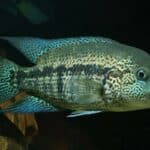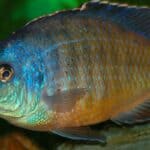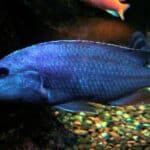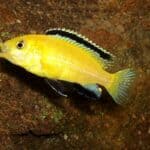All aquarium owners hope to create a serene and tranquil environment for their fish. Why is this so? By creating a healthy and peaceful environment, you are providing your fish with the best possible conditions in which to live and breed. This will result in a more vibrant and colorful aquarium that is sure to impress anyone who visits.
But does this mean staying away from aggressive species like the Kenyi Cichlid? Absolutely not! It all boils down to choosing the right tank mates for your aggressive fish.
Here’s everything you need to know about owning a Kenyi Cichlid.

Species Summary
The Kenyi Cichlid (Maylandia lombardoi) belongs to the Mbuna group, lives near rocks, and feeds on the biofilm present in these. It inhabits sediment-rich regions and is often found over sandy and muddy patches among the rocks of Lake Malawi, Africa.
It is an exciting Mbuna Cichlid but not a fish for every hobbyist. Like most Lake Malawi cichlids in Africa, it is a highly aggressive fish, so beginners should avoid it.
Kenyi Cichlids caught in the wild are very aggressive; however, captive-bred ones tend to be slightly less so. These cichlids will grow up to five inches in length and have distinctive coloring.
Just like most Mbunas (an African word meaning rock dweller), these fish are territorial, and once they establish themselves in a specific area in the aquarium, they will defend very aggressively. Because of this, these animals need aquariums with lots of rocks and formations of caves and crevices to make them feel more comfortable.
Besides, males of this species are often hostile toward each other and become very aggressive during the breeding season. Therefore, providing ample spaces to mitigate the frequency of these violent encounters becomes essential. The general rule of thumb is to maintain a ratio of one male to several females.
Kenyi Cichlid Care Guide
This section of the article will teach you everything you need to know about caring for your Kenyi Cichlid, from tank size and water changes to tank decor and fish behavior.
Tank Size
They need large aquariums, at least 40 inches long by 16 inches wide. In this space, you can keep a harem with one male and several females.
For community aquariums, maintain a minimum length of 60 inches.
Tank Mates
As incredible as this may seem, overcrowded aquariums help reduce these fish’s aggression and the formation of territories. However, it is best to avoid other species of the Maylandia genus, particularly those of similar appearance, as with all the certainty in the world, males will fight and fight to the death.
It is also ideal for the new fish to be placed in the aquarium simultaneously, in a group, to avoid being attacked by other cichlids that already dominate the environment.
So keep them only with other aggressive Mbuna species, such as Zebra Obliquidens, Demasoni Cichlid, Blue Socolofi Cichlid, Red Zebra Cichlid, Auratus, Snow White Cichlid, and Yellow Lab.
Same Species Tanks
Kenyi Cichlids are mainly kept in large aquariums in a harem system because of their aggressiveness. The aggressiveness of these cichlids is more restricted to males of the same species and other fish of similar silhouettes and colors.
As they are harem fish, keeping at least one male with at least three females is recommended so they won’t be too stressed because of male pursuits.
This mbuna is one of the group’s most aggressive species, making cohabitation between two males impossible. In addition to the extreme intra-specific aggressiveness, it is very violent with any other male approaching its territory.
Water Parameters
These fish live in places with highly alkaline water with high pH and excellent oxygenation. In these cases, the water quality must always be perfect; otherwise, any amount of nitrogen compounds in the water will prove incredibly toxic.
You should keep them in water between 73 and 78 F. The ideal temperature to optimize reproduction is around 77 F. The water should be hard and alkaline, with an excellent pH value between 7.6 and 8.4. to favor reproduction around 8.
The ideal hardness is between 10 and 20. Keep in mind that these cichlids cannot tolerate soft water and acidic pH.
What to Put in Their Tank
The idea is to imitate the places Kenyi Cichlids inhabit in nature: rocky coasts.
The aquarium must have many hiding places, with numerous rocks forming a rocky wall to take refuge and demarcate territory. This formation also reduces aggression as each individual forms their territory.
For the substrate, you can use aragonite or crushed corals, as this helps to increase the pH and hardness of the water. The presence of limestone is recommended because releasing minerals stabilizes the pH at high values.
The Mbunas even like to live with plants; they choose large, hardy plants. At the same time, these fish will pull them out of place because they love to turn the substrate.
And remember: It is vital that the rocks are placed directly on the bottom of the aquarium and not on the sand; that way, the fish can’t destabilize them, running the risk of breaking one of the tank’s walls.
Common Diseases
In addition to the “conventional” diseases to which all fish are subject, Kenyi Cichlids are prone to Malawi Bloat.
The first symptom is loss of appetite. African cichlids are always voracious when feeding. Only the female, when carrying eggs, loses her appetite.
Secondary symptoms include:
- abnormal abdomen swelling;
- wheezing;
- white stools;
- standing at the bottom of the tank and
- anting on the surface.
Red marks around the anus or skin ulcerations may appear; after this point, death usually occurs within 24-72 hours (in some cases, up to 1 week).
The leading causes of Malawi Bloat are the wrong diet (which will irritate the fish’s digestive/excretory system) and prolonged exposure to poor-quality water.
Food and Diet
The Kenyi Cichlid feeds on algae on rocks (biofilm) and plankton in the wild. In aquariums, however, their diet should consist of food for herbivorous fish. These are fish that have no problems feeding.
A high-quality flake or granule food enriched with spirulina is recommended. In addition, you also give them some treats often, for example, carrots, peas, and zucchini.
Beware of overfeeding, and never offer live foods or foods high in animal protein.
Lifespan
These cichlids have a lifespan similar to other cichlids in the same lake. Under optimal environmental and dietary conditions, they live around eight years and can easily reach 10.
Appearance
It has the unique appearance of the Mbuna cichlids, a robust, slightly flattened body with large pectoral fins, a large, showy dorsal fin, and a large mouth.
Males of Maylandia lombardoi are yellow. Females have a blue body with dark vertical bars.
Size
They are relatively small-sized fish, males are around 1.5 inches, and adult females are smaller, approximately 1.1 inches in length.
Behavior and Temperament
It is impossible to talk about the Mbunas without mentioning the high aggressiveness of these fish as the main characteristic of their behavior.
This is a very territorial and intolerant species of (at least) its own kind. Sometimes the male’s aggression is directed against a similarly colored fish.
These African cichlids form a social hierarchy that functions inter and intra-species. Thus, a male is the predominant fish in the tank and has the most aggressive behaviour, chasing everyone (mainly males) that approach, not only during the spawning period.
Among the species that make up the community aquarium, there will be a dominant male, which will not tolerate any other male in its territory.
Even in larger aquariums (110 gals), some individuals will not accept the presence of another male of their species in the tank. The idea is to keep a “harem” of 2-3 females for each male.
The hierarchy is best observed when there is no spawning activity in the tank. When spawning, both the male and the female become more aggressive and can “break” the hierarchy.
Breeding
Being all oviparous, female African cichlids spawn, and then the eggs are fertilized by the male in the substrate.
If the aquarium’s water, food, and filtration are within optimal parameters, African cichlids will spawn frequently. These Mbunas begin to spawn from 7 months of age.
Mating takes place in a place previously chosen by the couple, and the male attracts the female in a ritual of movements. The female will lay her eggs in the soil, fertilizing the male.
Females will carry the fertilized eggs in their mouths and incubate them. The larvae will hatch in about ten days. When they hatch (10-30 larvae), they will remain in the mouth for a few days (two to three weeks, depending on the temperature). At the end of the incubation period, the fry is released, fully formed, and self-sufficient in looking for its food.
When females carry eggs, they refuse to eat (a feature that can be confused with dropsy disease); your mouth feels full, making chewing movements frequently.
It is important to note that a female Kenyi Cichlid can lose her position in the group hierarchy. So we recommend waiting as long as possible before moving her to another location unless she is being harassed a lot by the male.
Gender Differences: Male vs Female
While they are small, both are blue, with dark vertical stripes. The males gain a yellow coloration, ultimately losing the bars or keeping some “traces”.
Females retain the same colour from an early age.
Kenyi Cichlid Fun Facts
- “Stripping fry” is the name of the technique that breeders use to manually remove the fry from the mother’s mouth and finish their incubation artificially in a separate aquarium, suitable for this purpose.
- For healthy and effective growth of fingerlings, partial water changes should be frequent, and the amount of animal protein (such as brine shrimp) should be higher (70% vegetable, 30% brine shrimp). The temperature should be between 28-29°C to increase metabolism and appetite.
- Hybridity is a common thing among these fish. Different species of the same genus will be able to breed (especially when there is not a good number of females of their species available), producing hybrid offspring that are usually sterile, weak, without intense coloring, and often with deformations. The hyper dominant male, in particular, will also try to breed with females of other species in the same genus.
- This species has been largely bred in captivity, and the vast majority of lineages in the primary trade consist of degenerate fish with very irregular vertical bars.
References
Couldridge, V.C.K., 2002. Experimental manipulation of male eggspots demonstrates female preference for one large spot in Pseudotropheus lombardoi. J. Fish Biol.
Konings, A. (1990). Konings’s book of cichlids and all the other fishes of Lake Malawi. TFH publications.
Maréchal, C., 1991. Pseudotropheus. p. 401-415. In J. Daget, J.-P. Gosse, G.G. Teugels and D.F.E. Thys van den Audenaerde (eds.) Check-list of the freshwater fishes of Africa (CLOFFA). ISNB, Brussels; MRAC, Tervuren; and ORSTOM, Paris.
Ribbink, A.J., B.A. Marsh, A.C. Marsh, A.C. Ribbink and B.J. Sharp, 1983. A preliminary survey of the cichlid fishes of rocky habitats in Lake Malawi. S. Afr. J. Zool.
Romero, P., 2002. An etymological dictionary of taxonomy. Madrid, unpublished.








